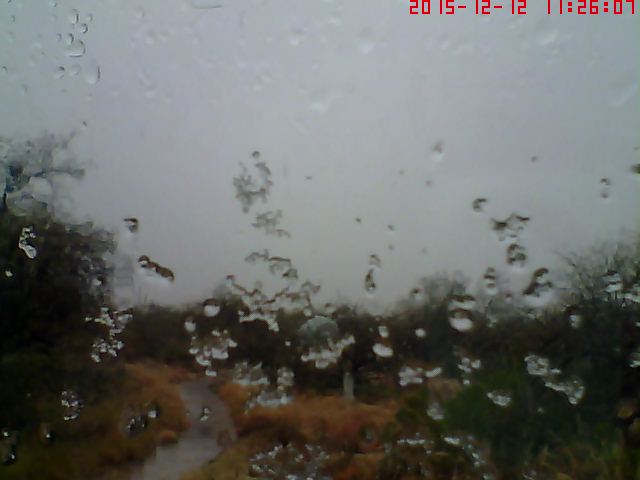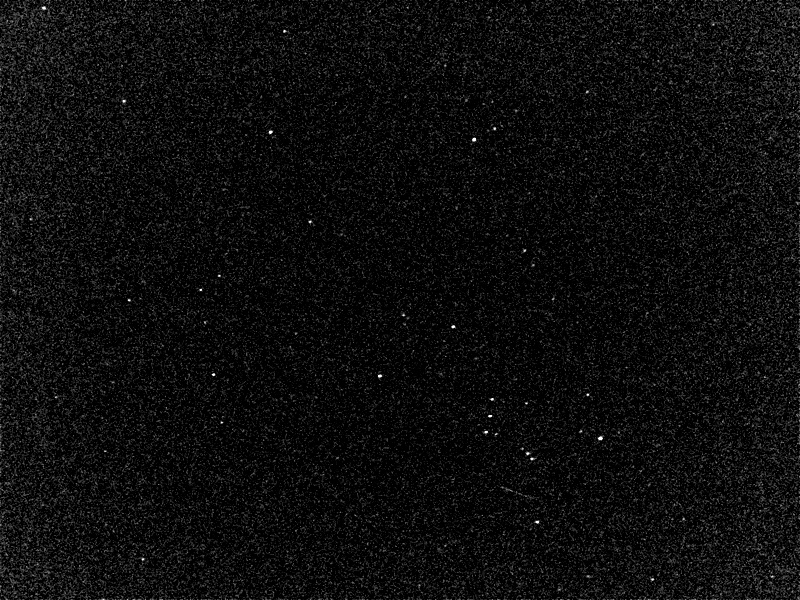Rocket Launch, Snow;
Geminid Meteors, Comet C/2013 US10 Catalina
Posted: 14 December 2015
Wednesday, 9 December 2015, dawned mostly clear but clouds from an approaching storm system began appearing mid-morning. Thursday morning dawned with some clouds. I was able to see a trail from the Juno rocket launch in New Mexico that occurred at 0700 MST:

Friday night, 11 December, rain came, with 0.5" by dawn on Saturday. The rain turned to a couple of brief snow showers late in the morning, which stuck for a few minutes:


The observatory dome is just visible below center in the top photo.
The rain total was 0.74" from this storm. Sunday, 13 December, dawned clear (and cold; 32°F), and with a forecast of a clear sky for that night, giving hope that I would be able to view the Geminid Meteor Shower near its peak.
|
Open: Sunday, 13 December 2015, 2127 MST Temperature: 39°F |
Session: 895 Conditions: Clear |
Set up a chair on the observatory patio to watch the Geminid Meteor Shower. Mounted the iPhone 6s Plus on a photographic tripod using the Orion SteadyPix Universal Smartphone Telescope Photo Mount.
2145-2315 MST: saw 54 meteors, most of which were Geminids. Most were faint but there were a few brighter ones. I tested NightCap Pro's new "Meteor Mode" (to be released to the public soon) and during about 90 minutes of imaging, 123 images were automatically saved. Meteors were detected in only two images, of which this was the best (visible below Orion's belt and sword):

Unfortunately, the brighter meteors were not in the sky where the camera was pointed. Rats.
Ended the session once I got too cold.
|
Close: Sunday, 13 December 2015, 2333 MST Temperature: 38°F |
Session Length: 2h 06m Conditions: Clear |
I woke up early Monday morning, 14 December, to try to see Comet C/2013 US10 (Catalina). 0445 MST: observed the comet in 7x50 binoculars. It was faintly visible. It was definitely not a naked eye object. I mounted the D7200 DSLR on a photographic tripod and did some imaging. I used the Gerd Neumann Bahtinov Mask for Camera Lens to focus on the star Arcturus. This f/4, 15 seconds, ISO 5000, FL 30mm, photo shows Comet C/2013 US10 (Catalina) low in the eastern sky, two meteors (one of which was a Geminid (vertical trail), some airglow, and a cloud:

Mouseover or tap on image for labels
This cropped f/5.6, 5 seconds, ISO 25600, FL 140mm, image shows the comet and a hint of its two tails (at 1 o'clock and 5 o'clock):

During the 25 minutes that I was outside I saw 12 meteors, most of which were Geminids.
I have posted my book review of "The Lost Constellations" by Dr. John Barentine.
Comments are welcome using Email. If you are on Twitter you can use the button below to tweet this report to your followers. Thanks.
Cassiopeia Observatory Home Page
Copyright ©2015 Michael L. Weasner / mweasner@me.com
URL = http://www.weasner.com/co/Reports/2015/12/14/index.html
